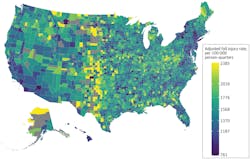Falls are a leading cause of hospitalization and institutionalization for older adults in the U.S. and fall prevention efforts are an important part of geriatric education and health according to a new report released by the University of Michigan.
The University of Michigan study found that despite prevention efforts, falls increase by about 1.5% annually, with wide variations in incidence based on geography.
“It could be that efforts aren’t working–or that they are, by mitigating even worse potential injury risk in the population,” said Geoffrey Hoffman, assistant professor at the U-M School of Nursing and co-author of the research letter, which appears in JAMA Network Open. “Either way, more investment in prevention, such as education and funding for fall education and prevention programs, would help.”
It’s not clear why falls are increasing. Researchers adjusted for age, but the study could have captured population changes in health and function, or in prescribing patterns for medications associated with increased falls. Or, Hoffman said, the results could reflect other factors–for instance, a more active older adult population could result in more falls. Finally, the findings could reflect other changes in treatment and care, or how fall injuries are administratively coded.
Hoffman was surprised by the wide variation in fall injury rates between low and high injury areas. Counties with the highest (in the 90th percentile) fall rates had rates that were roughly 75% higher than counties with the lowest (10th percentile) fall rates.
“This suggests that environmental factors may play a larger role in falls than has been previously discussed and that population-targeted risk management to target-specific areas may be cost-effective and beneficial,” Hoffman said.
Higher-risk areas were in the Central Plains and South. However, these areas are less populated so data is sparser and potentially less reliable, Hoffman said.
Lillian Min, associate professor of geriatric and palliative medicine at Michigan Medicine, said the research shows the potential for using national Medicare data to track falls for older adults on a large-scale.
“Such monitoring may capture benefits of future more effective prevention efforts or identify harms, such as increasing use of fall-risk inducing medications,” said Min, senior author on the study.
While the geographic variability among low and high areas was surprising, the overall findings were not, Hoffman said.
“Severity of illness is increasing among Medicare beneficiaries, with older individuals living longer. So there is a shift in demographics, plus changes in enrollment trends,” he said. “We also have insurance-related limitations. Medicare covers treatment for injury, but not for long-term care that may help maintain function in older individuals, so it’s difficult to mitigate these risks.”
Hoffman said that, until recently, healthier patients enrolled in Medicare Advantage. Because the study looked at fee-for-service beneficiaries (and not those in Medicare Advantage), it may have also captured changes in underlying health risk.
Falls affect 4.5 million older adults in the U.S. and cost Medicare $15 billion to $30 billion annually. Previous reports of increased fall injury trends are limited because data were self-reported and potentially undercounted by excluding moderate injuries. This study examined national trends and geographic variability in fall injuries.
Researchers analyzed claims from 2016-2019 for adults 65 and older. The 1.5% average annual increase translates to an additional 106,000 new fall injuries, or an estimated $1 billion in new fall injury spending over the study period.





